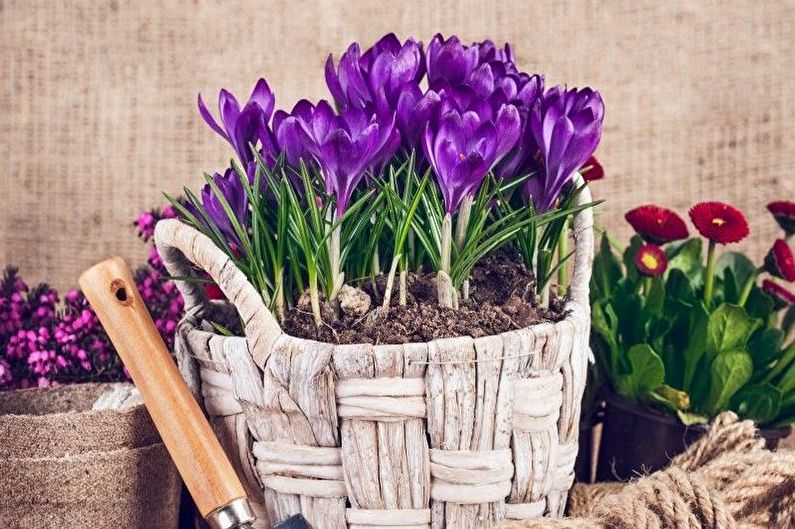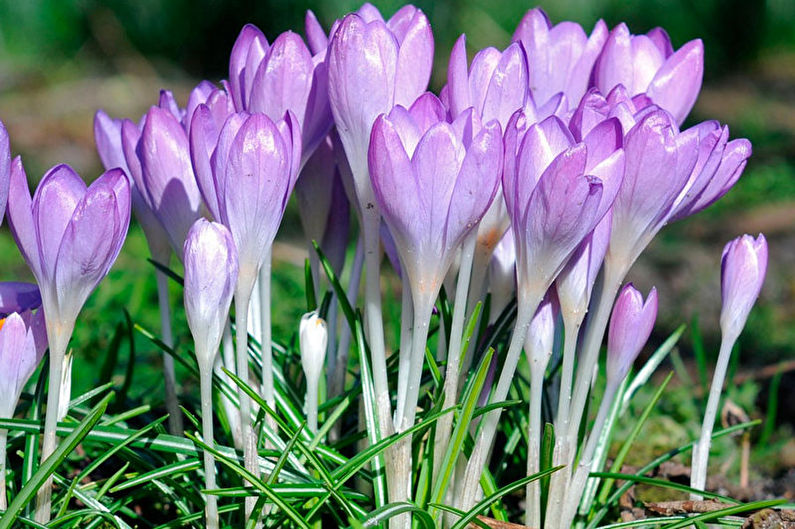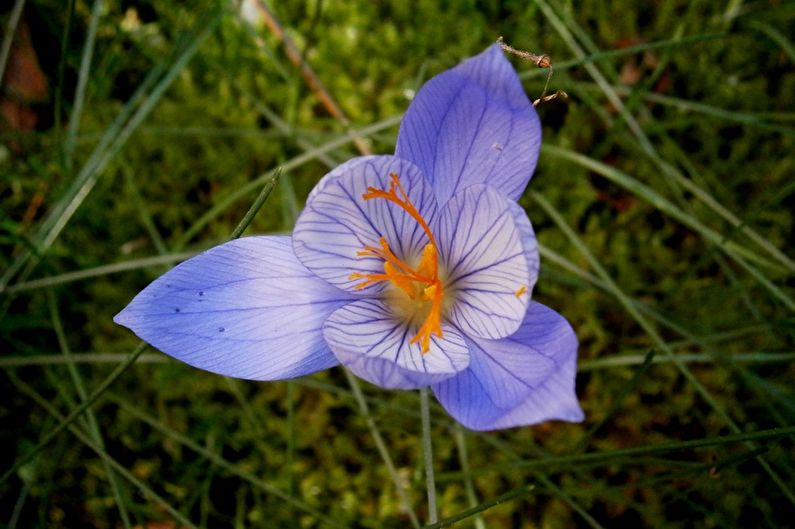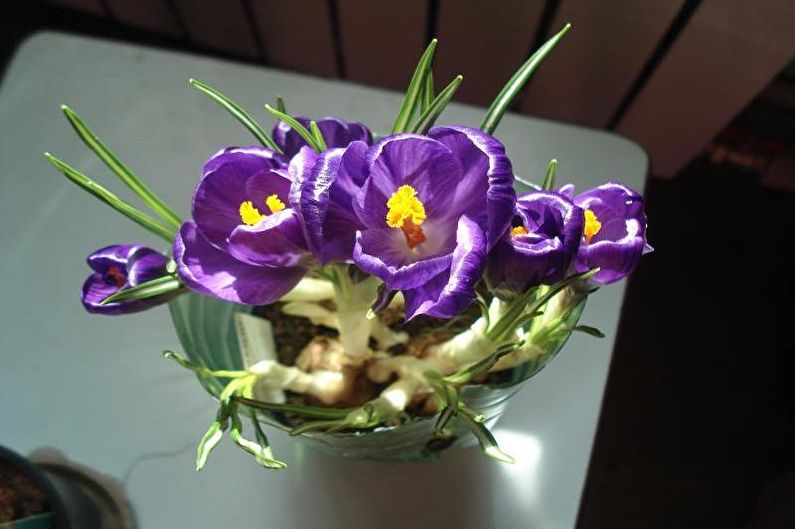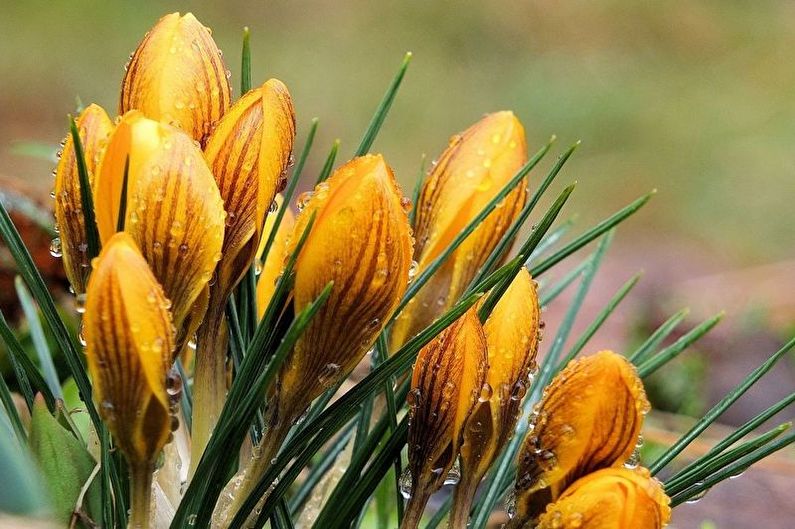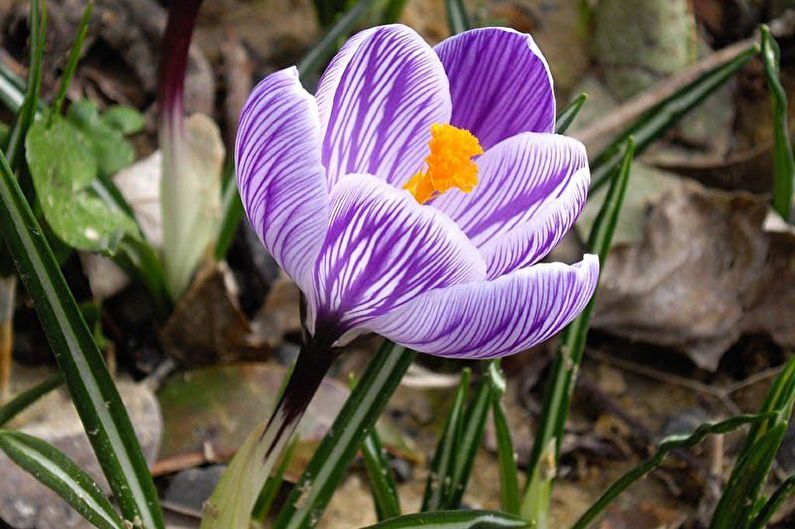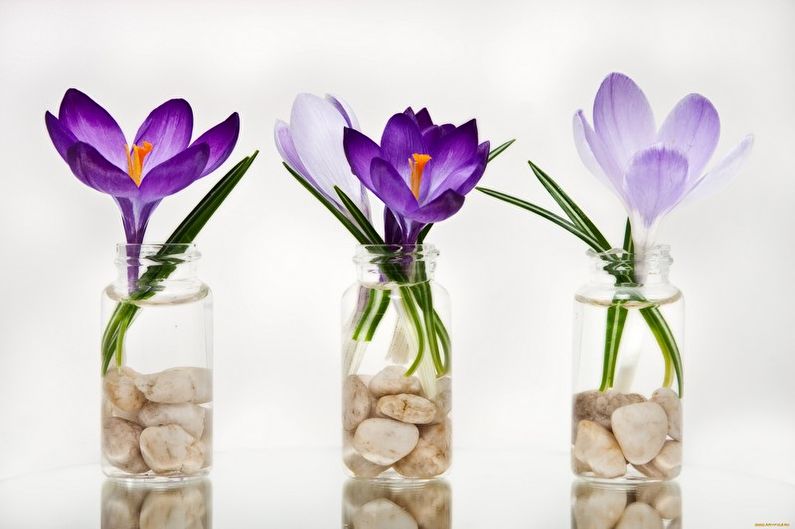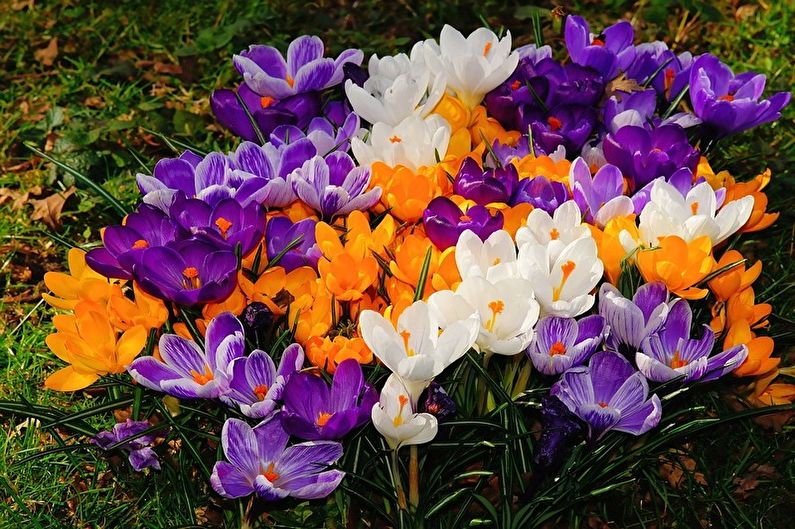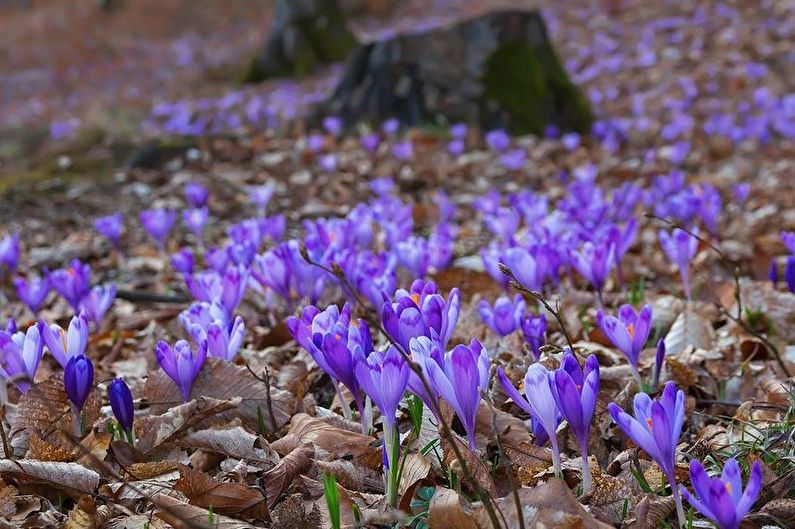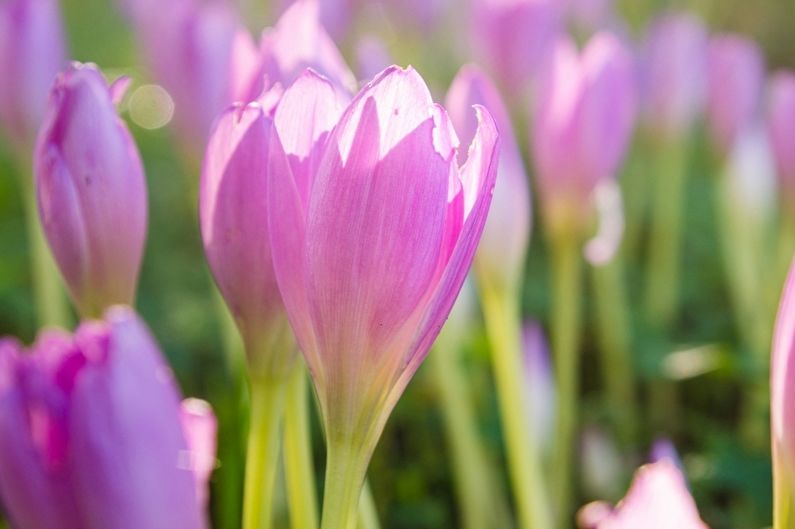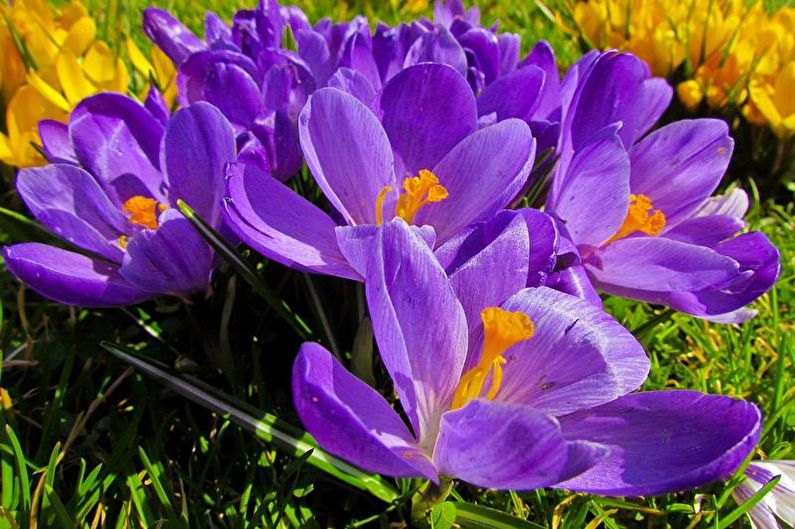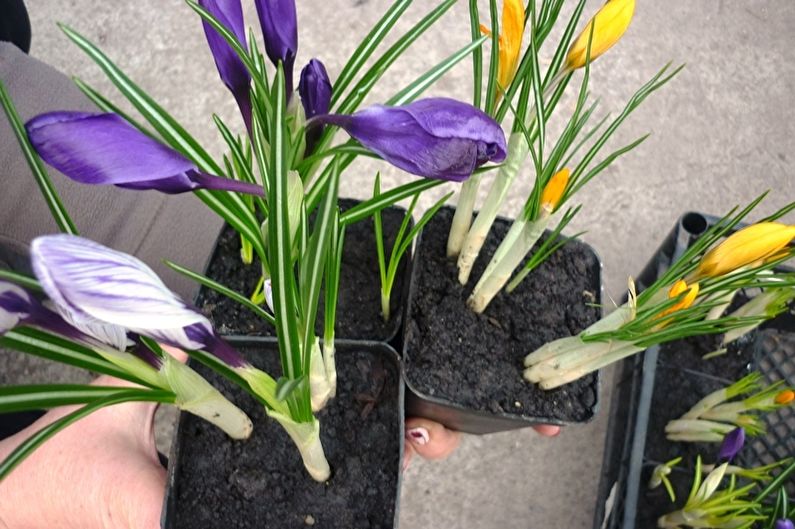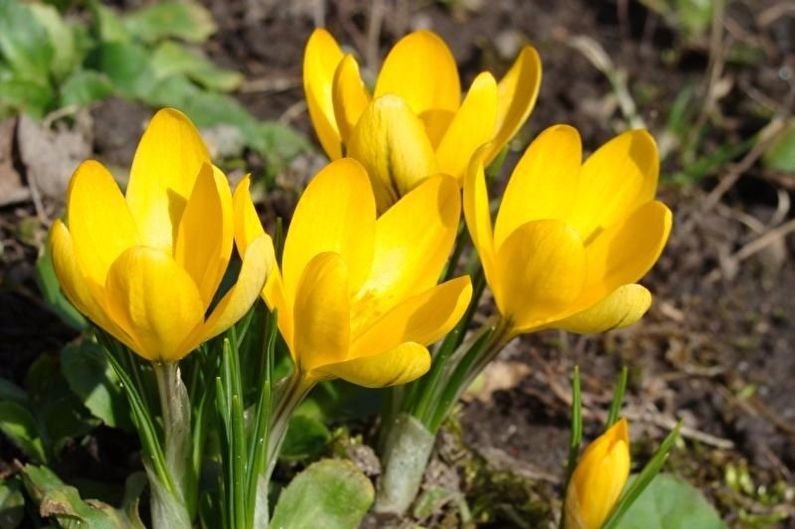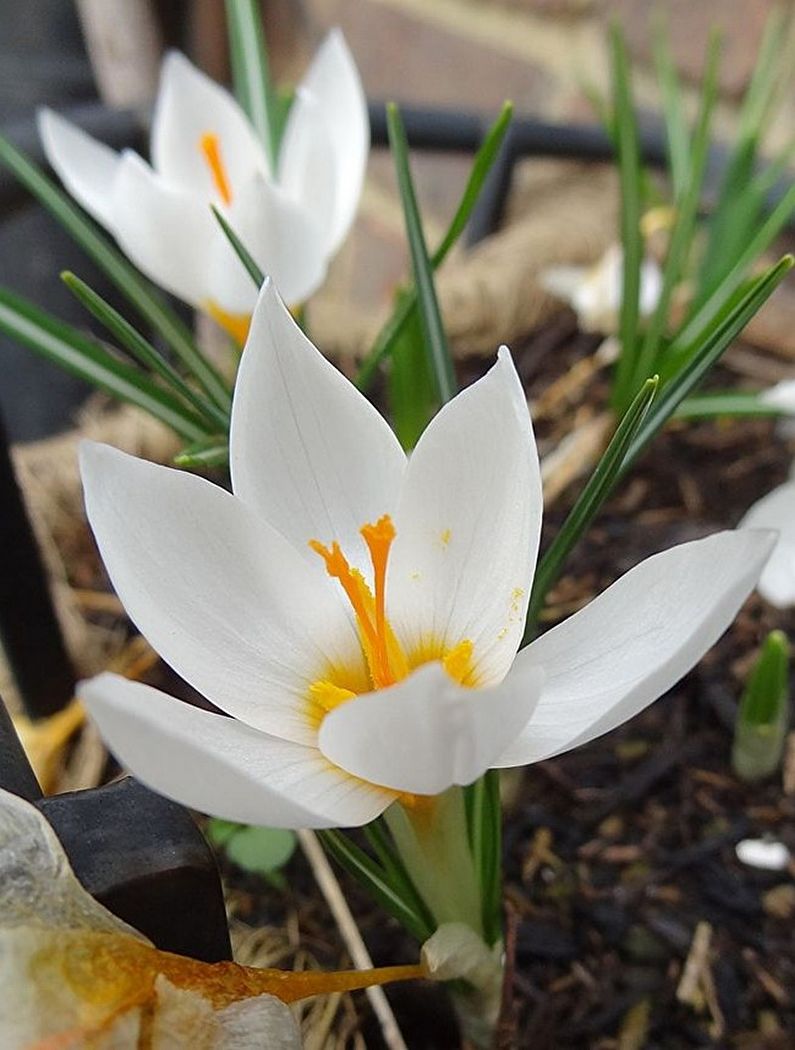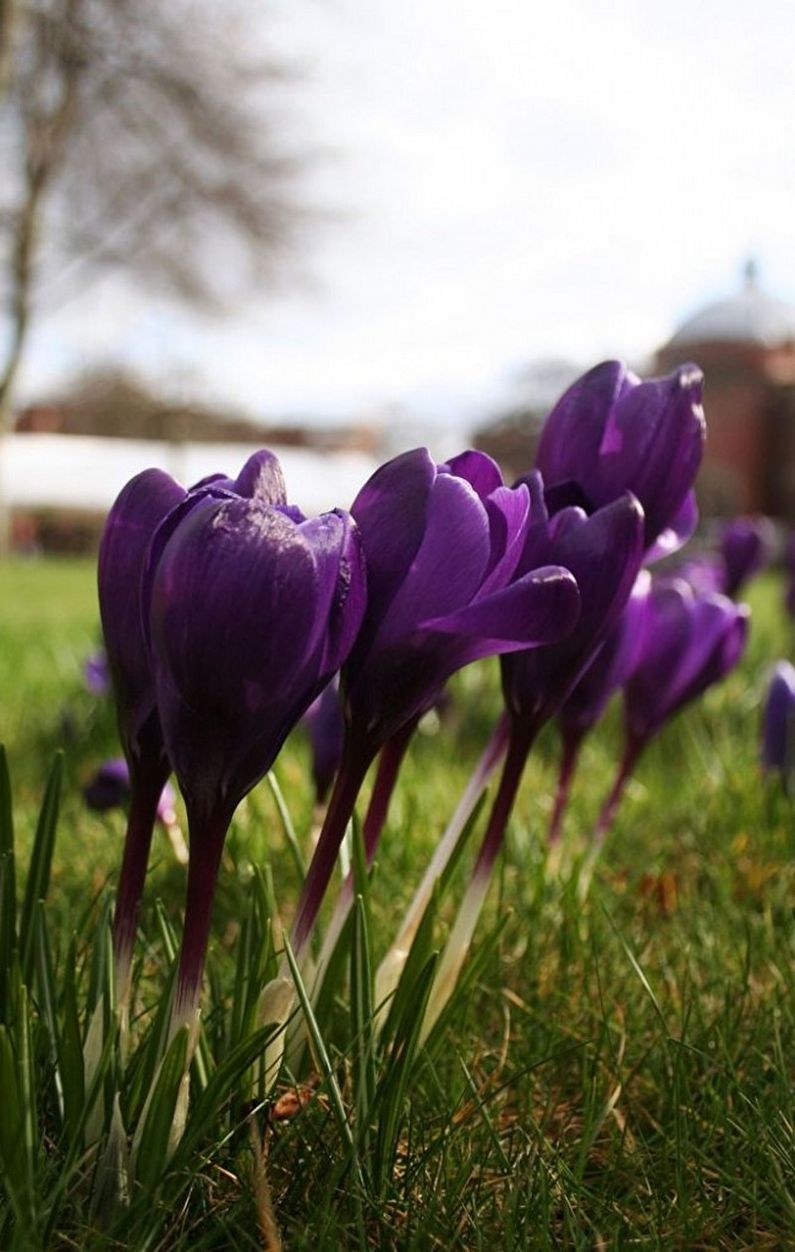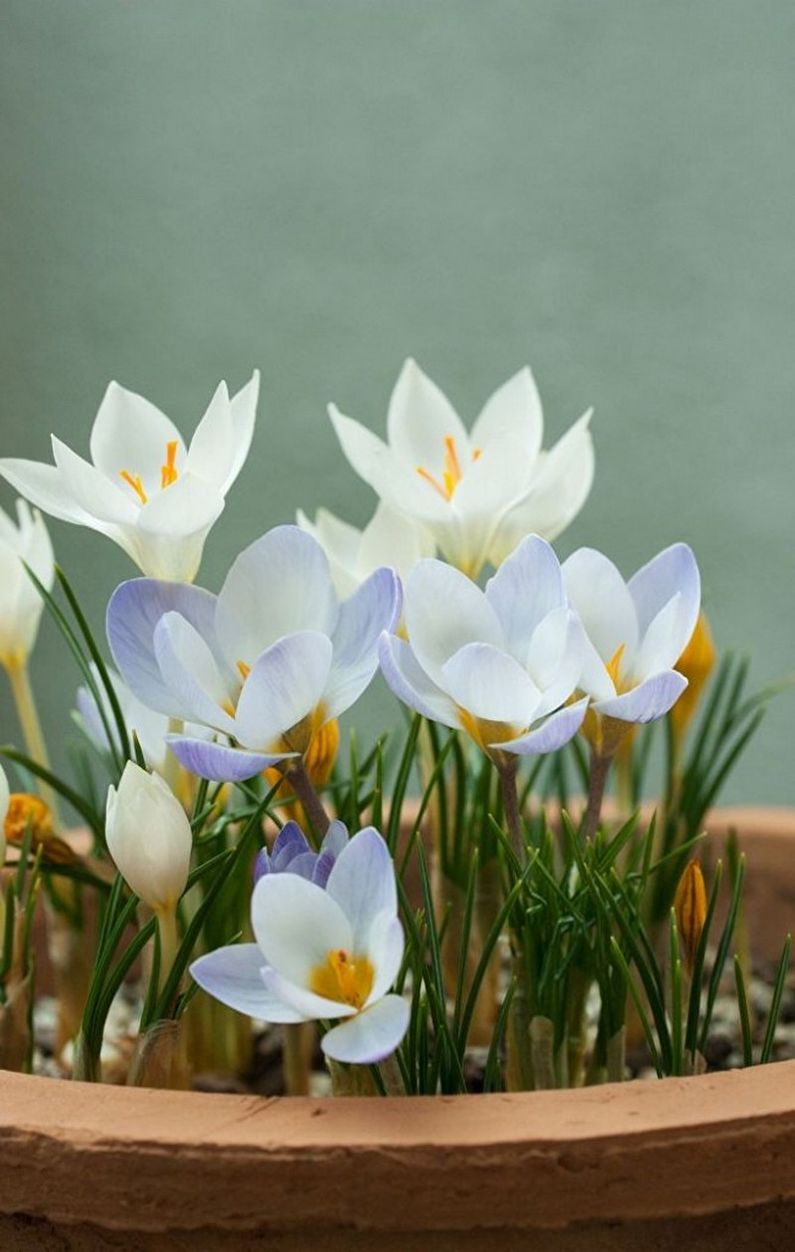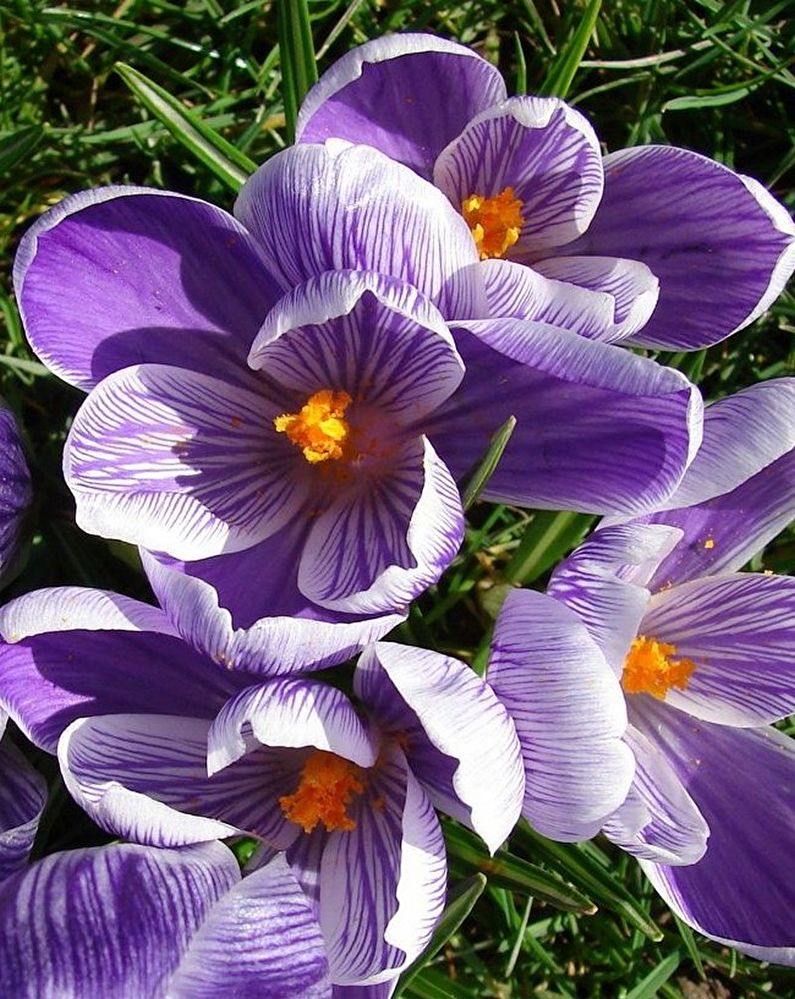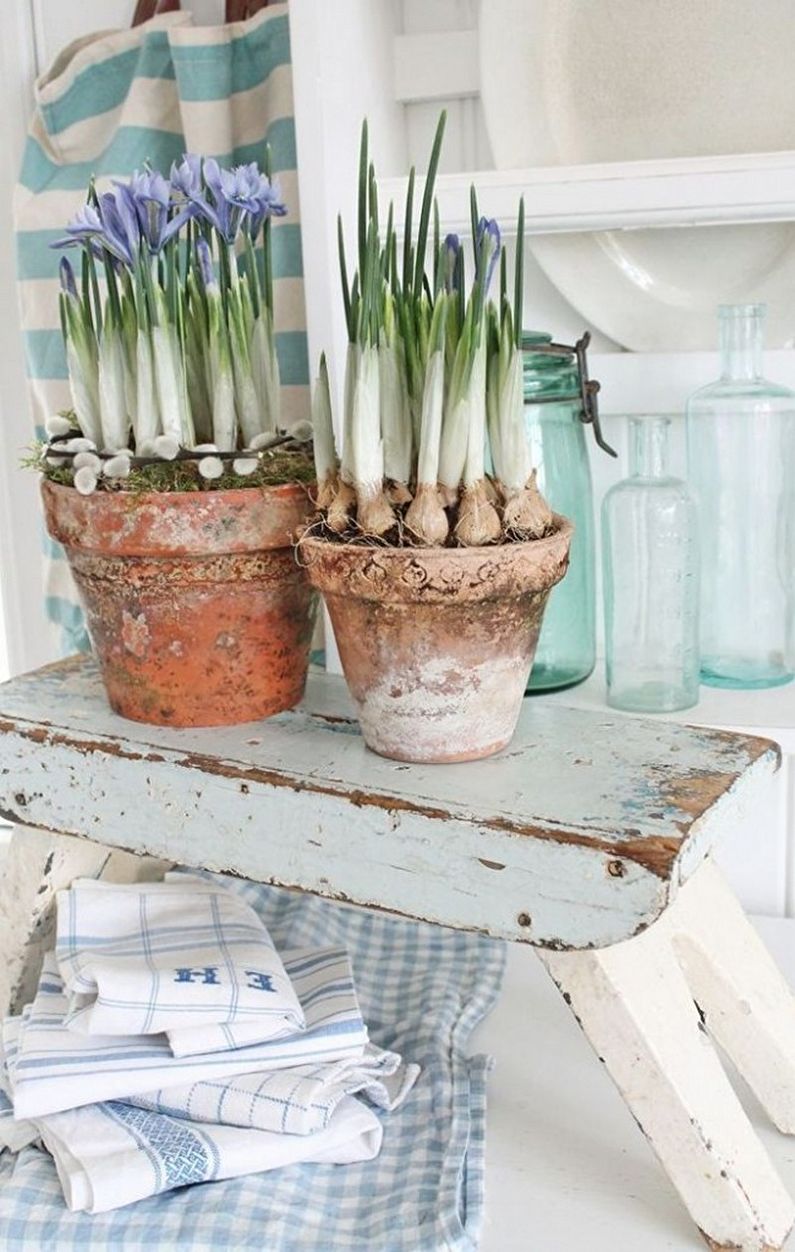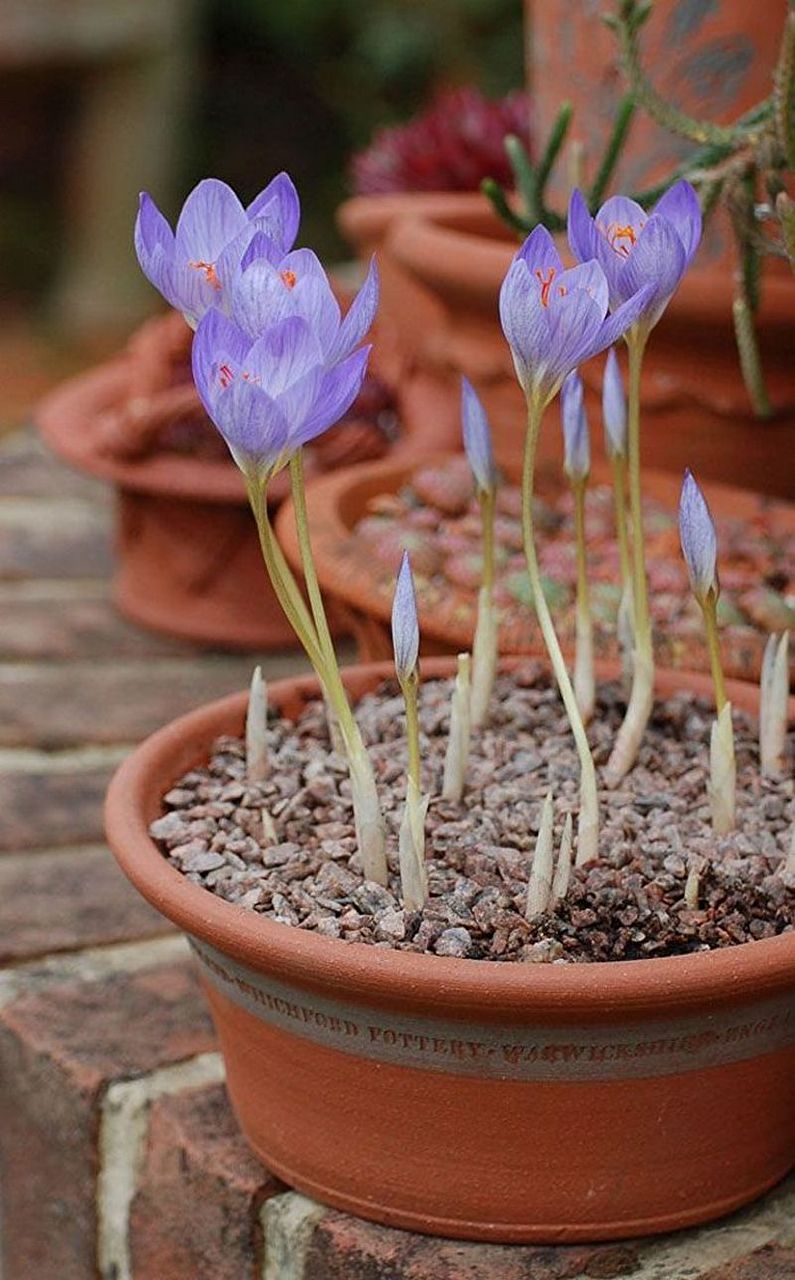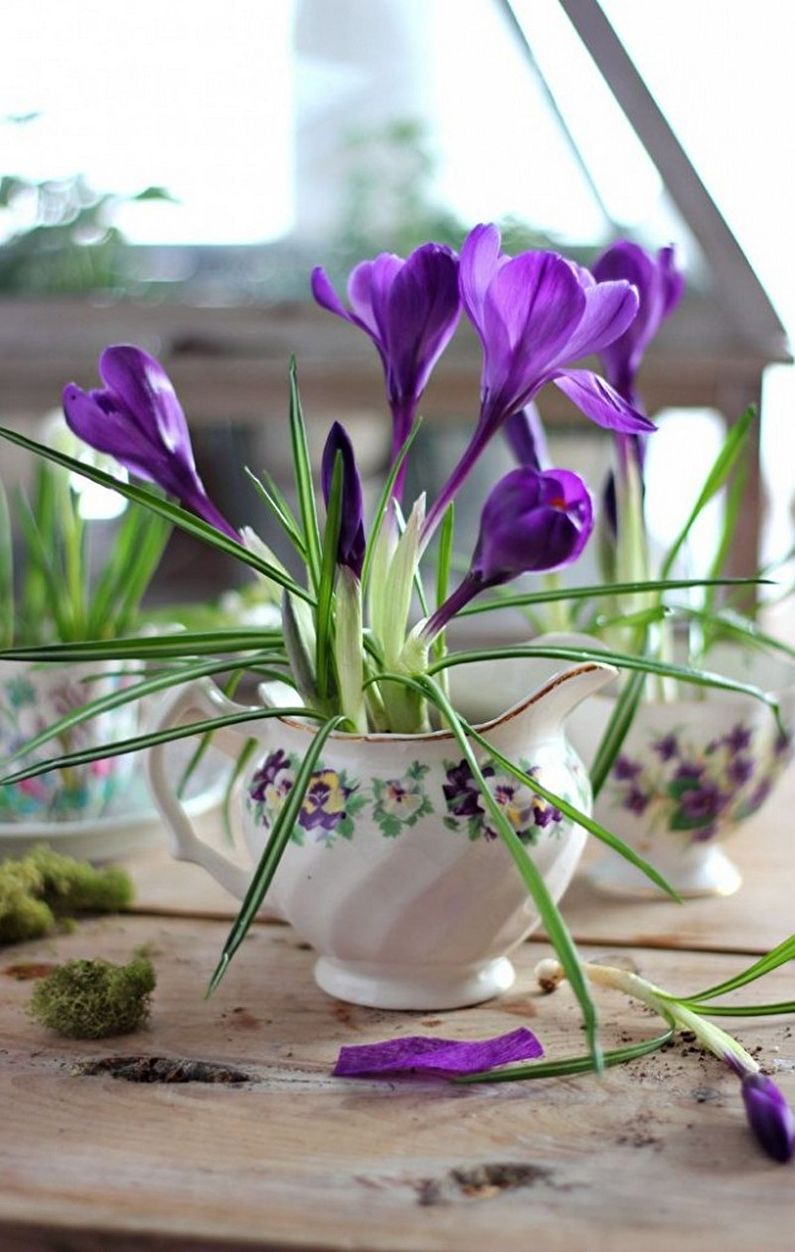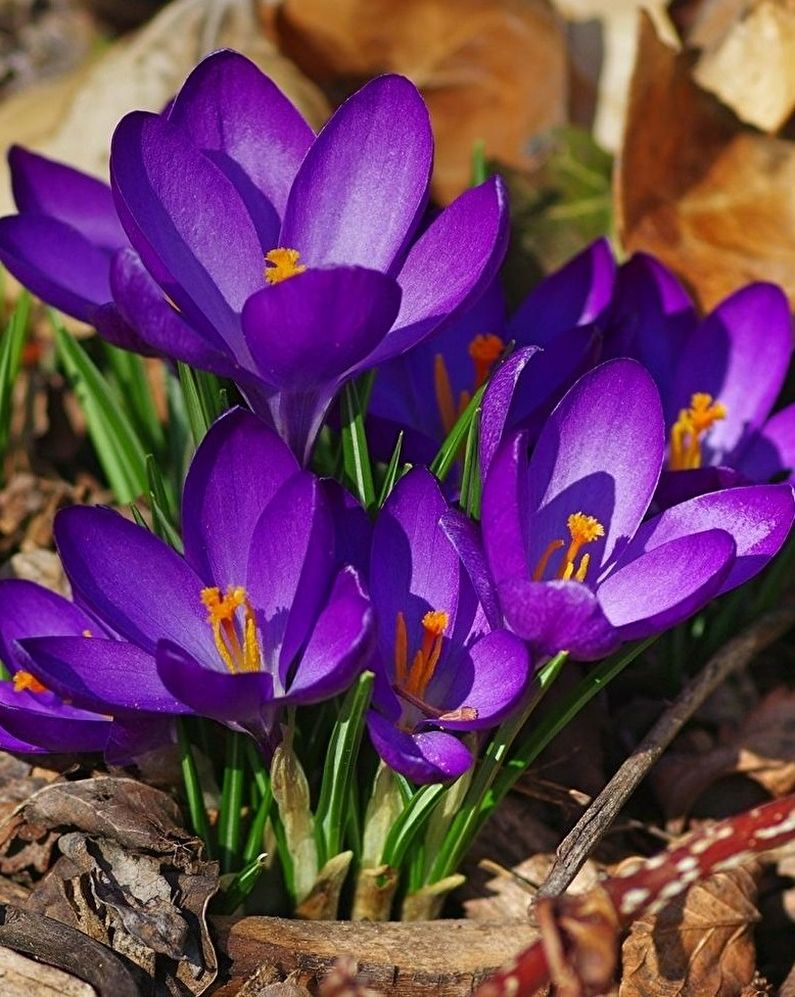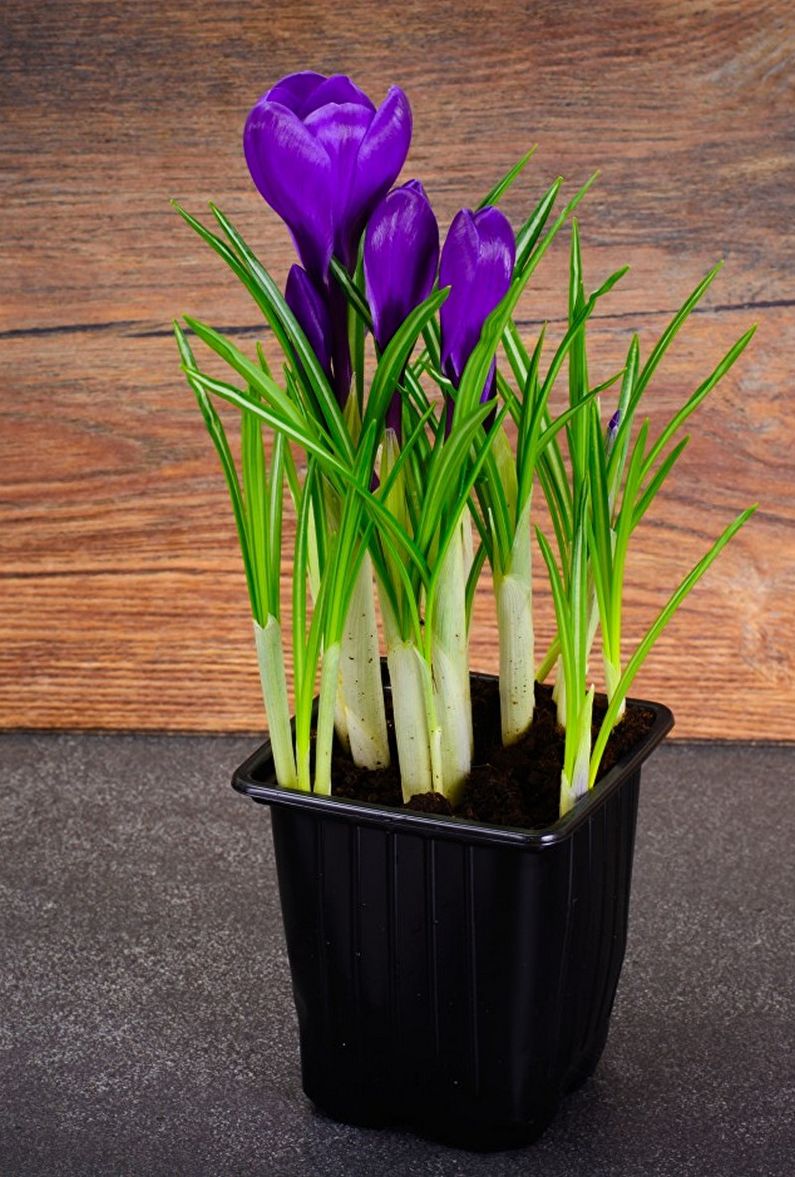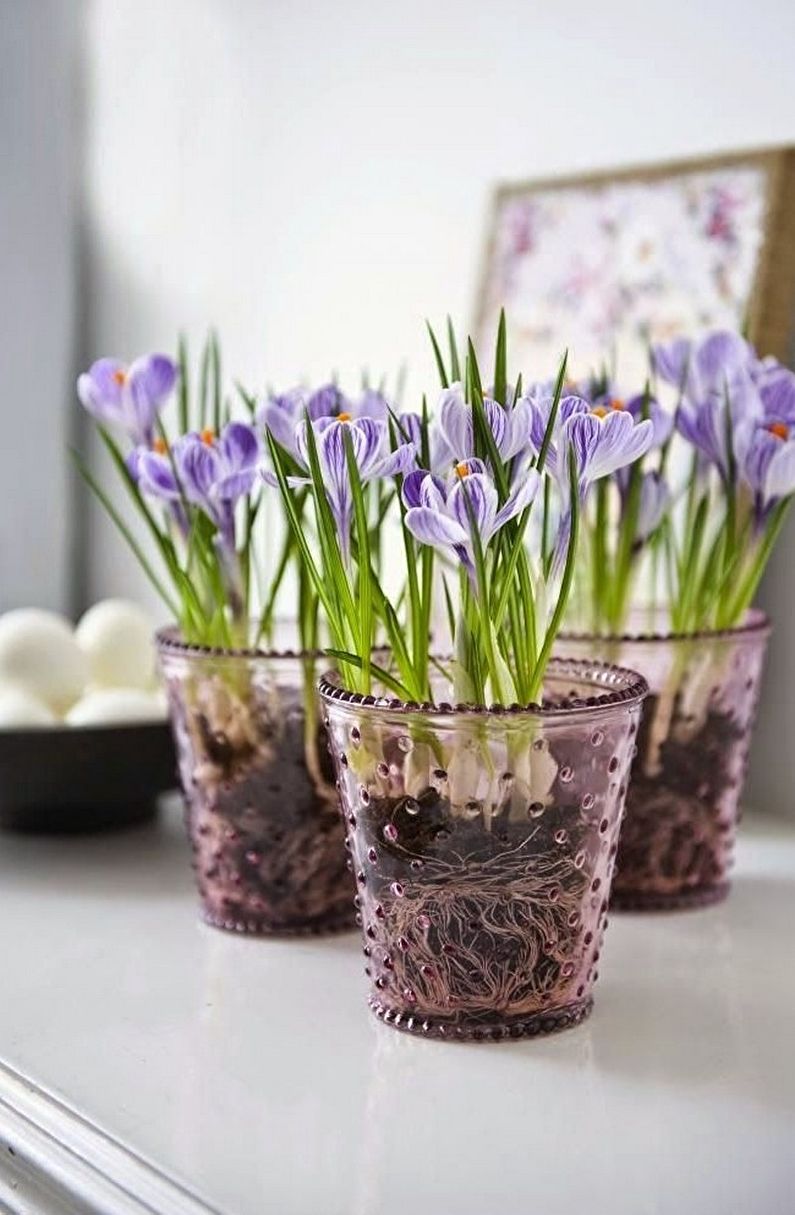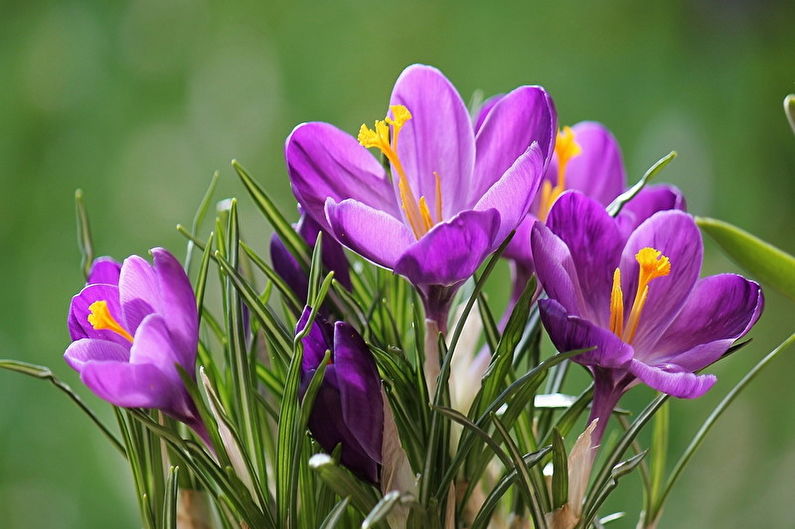
Crocus is a grassy plant for open ground, one of the most beautiful primroses. It belongs to the number of stunted plants, since the height rarely exceeds 10 cm, and the diameter of single goblet flowers ranges from 20 to 50 mm. The creation of the first cultivator dates back to the end of the XIX century, and since then tireless work has been carried out to grow new hybrids, which every year delight amateur gardeners and landscape designers. Saffron was famous and widely used many centuries ago. Ancient Egyptian doctors wrote about him, in the Roman Empire he acted as a means for treating cataracts, as well as a raw material for obtaining fragrant oil. In Spain, there are whole fields where crocuses are grown for spices.
The main types of crocuses
In the world there are about 80 species of saffron and 300 varieties. Among them, there are cultures whose bloom occurs in the early spring, as well as those that bloom in autumn. The culture has a rather large color spectrum - white, blue, purple, yellow, purple-red flowers are monophonic or variegated.
Saffron
The sowing species is one of the most cultivated in the world. It is grown on an industrial scale, since it is precisely its flowers that are known to everyone as the “saffron” spice used in the preparation of various dishes. India is considered his homeland, and the one that is being grown now is already a hybrid variant, born as a result of crossing several varieties. This undersized plant has white or light purple flowers with a pleasant aroma of violets. Leaves appear along with flowers, and all the beauty of flowering can be observed for two weeks. Moreover, each flower lives no more than three days.
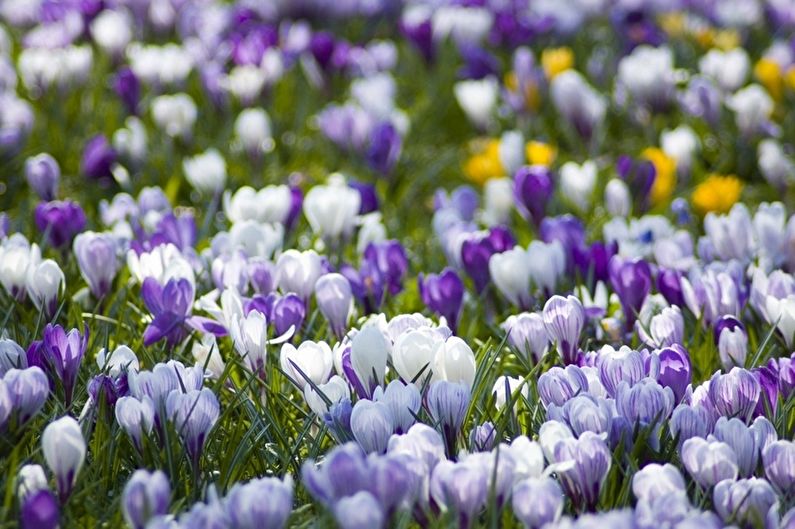
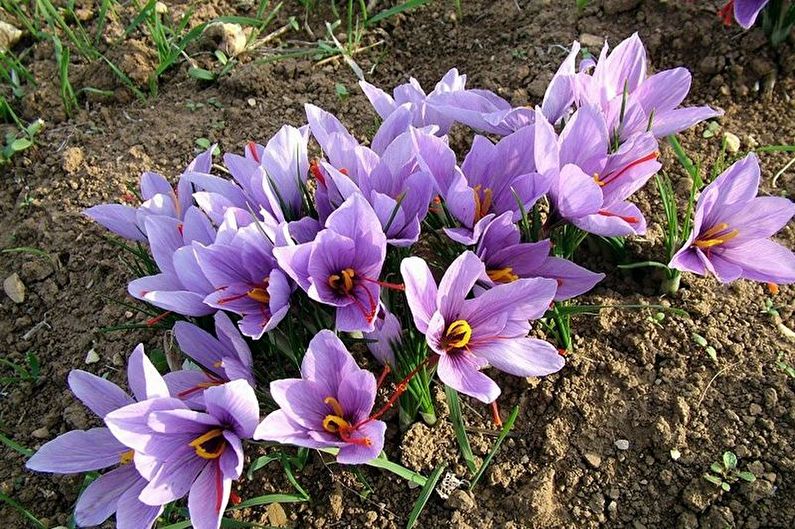
Spring crocus
This saffron can truly be called the progenitor of many species that exist today. It is the most sought-after material for creating numerous hybrid varieties that are grown around the world. Its natural growing conditions are high-mountain Alpine meadows, where the plant is full of purple or purple flowers with a diameter of up to 5 cm.
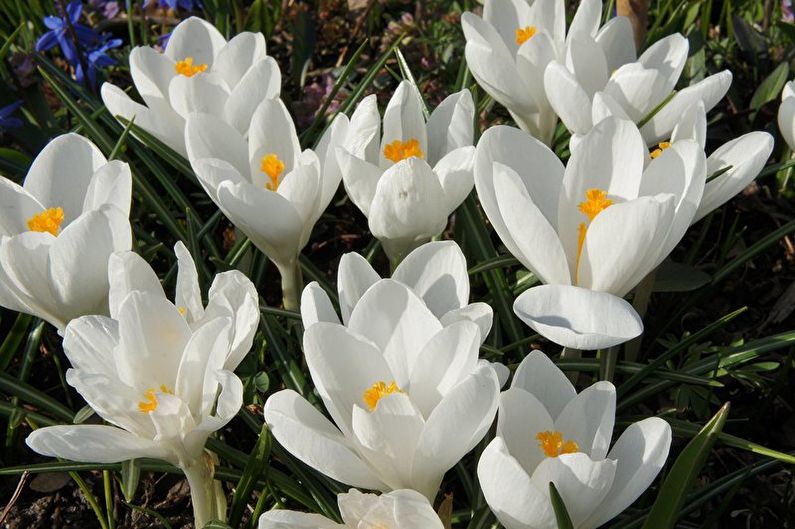
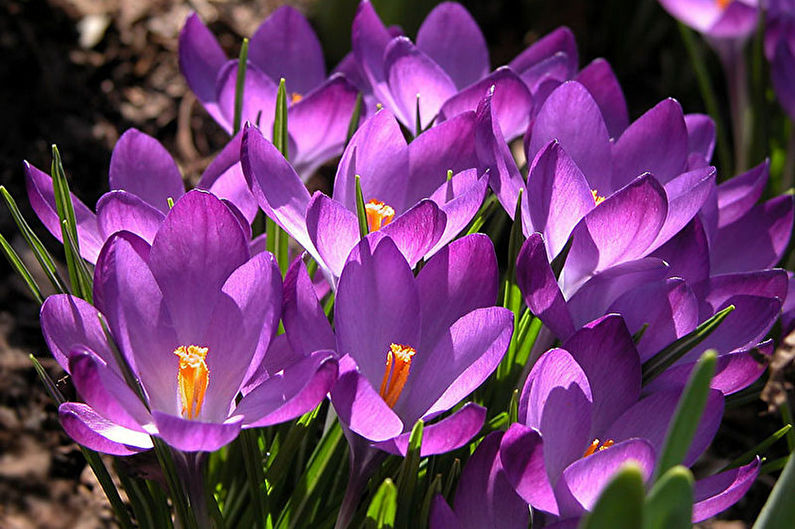
Golden saffron
One of the botanical plant species. It can rightfully be called the highest, since the height reaches 20 cm. Flowers of a yellow-golden hue appear along with narrow leaves. The period of rapid flowering occurs in April, and its duration is about three weeks. Today, in the process of crossing with other species, golden saffron has many other interpretations, in particular a two-color variety.
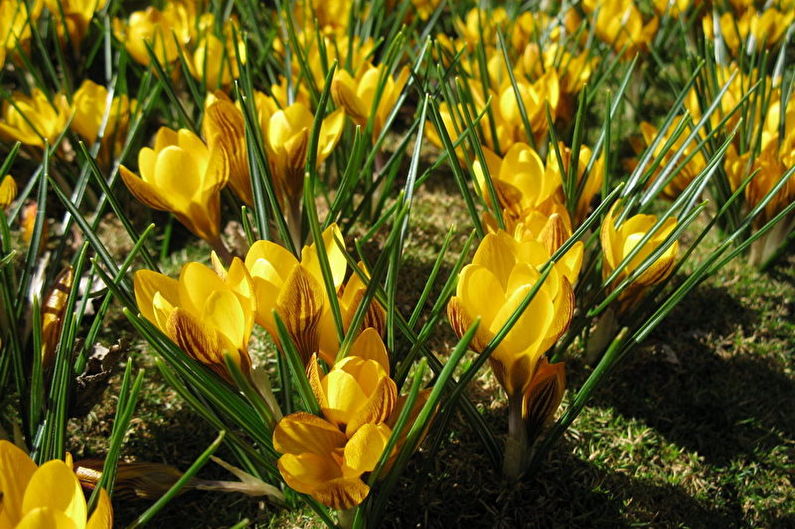
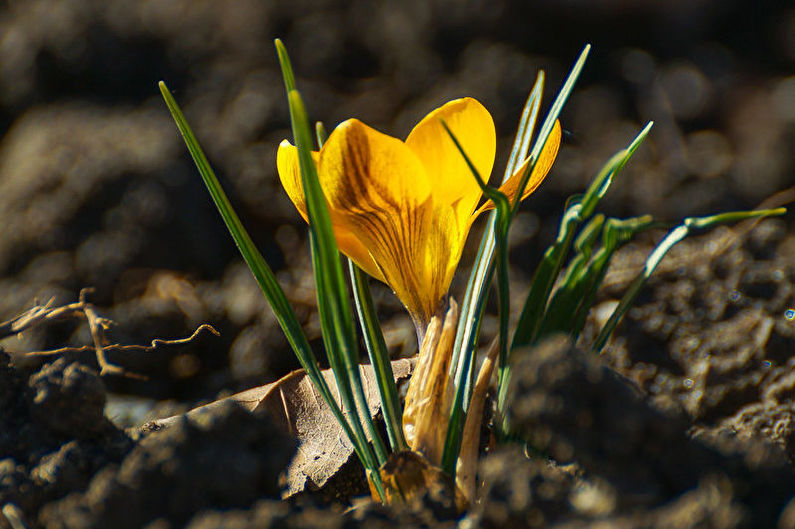
Crocus Pallas
A fairly short saffron has a height of not more than 50 mm. Its solitary flowers, seeming outlandish stars, have delicate purple-pink hues with a purple base, and the diameter of the bud reaches 5 cm. The first narrow-linear leaves appear in mid-spring, and saffron blossoms in September. This contrasting spectacle of miniature flowers against the backdrop of a withering garden can be observed throughout the month.

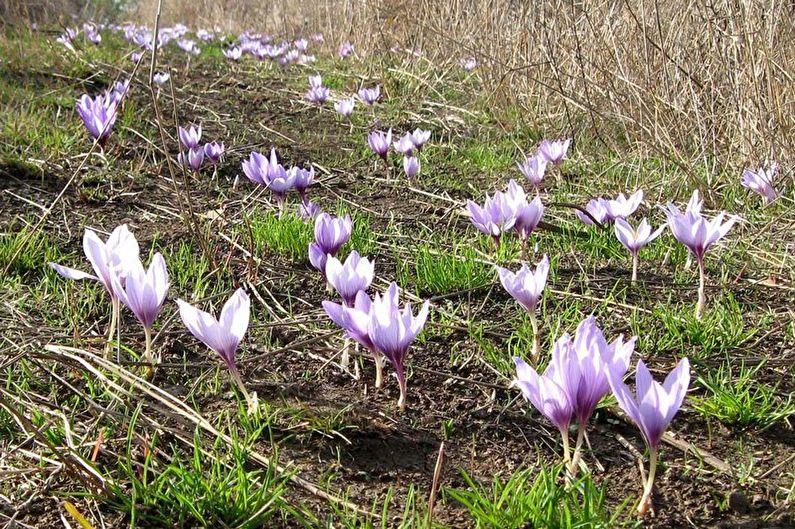
Crocus Tomasini
This species is notable for its unpretentiousness, therefore it is quite popular, especially among lazy gardeners who want to have a beautiful garden plot without unnecessary hassle. The plant feels great in darkened areas, quickly adapts to any conditions and does not require special care. In the wild, Tomasini crocus can be found in the Balkans, Bulgaria and Hungary. The flowers have pink and purple shades with a white core.
During lush flowering, the culture forms an excellent continuous carpet, which perfectly looks in the foreground of the lawn, as well as under the crowns of trees that have not yet blossomed. This culture can be grown in apartment conditions in pots. Several flowerpots with different types of saffron will create an interesting decorative composition at home. Often they are planted for some holidays - March 8, Valentine's Day, etc. For this, choose hybrid Dutch varieties that are unpretentious and have a large number of buds with large flowers. These include the Crocus “Jeanne d’Ark” with white flowers, the “Stripped Beauty” of colorful colors, the bright yellow “Lajest Yellow”.
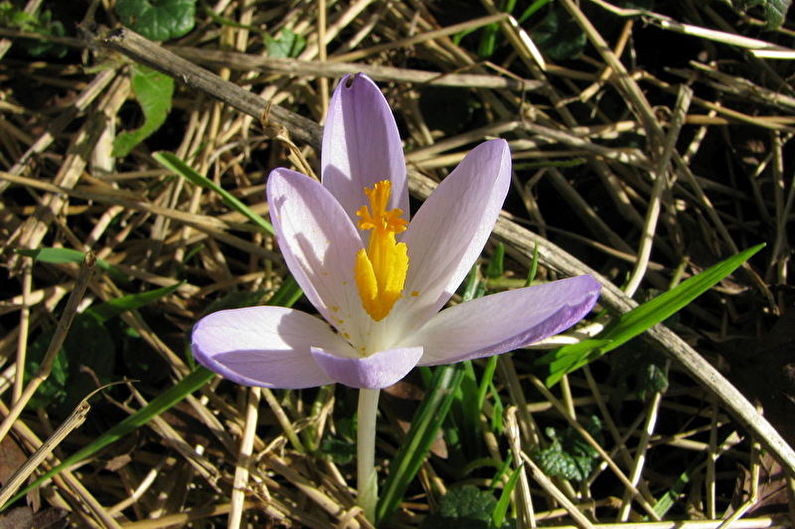

Proper crocus care
Although saffron, for the most part, is not whimsical to conditions, it still needs some care. To admire the lush flowering of bright large flowers, you need to "settle" it in optimal natural conditions, and if the plant is grown in an apartment pot, the conditions should be as close as possible to street conditions.
Lighting
This culture loves good light, so it’s worth planting saffron on the south side of the house or installing flowerpots in this place. But you need to consider that he does not like direct scorching sunlight - it is better to organize the partial shade that the shrubs will create. In apartment conditions, if it is not possible to place flower pots on an open balcony, you can build artificial lighting with light bulbs. In this case, it is necessary to monitor the temperature regime.
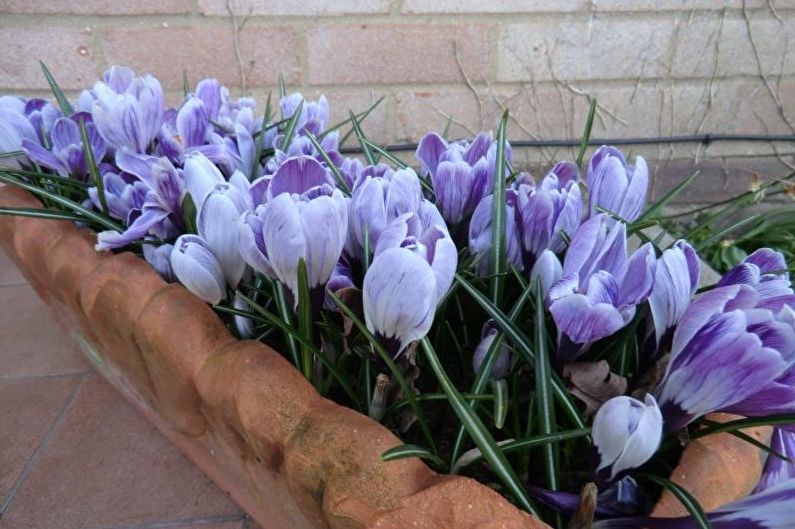
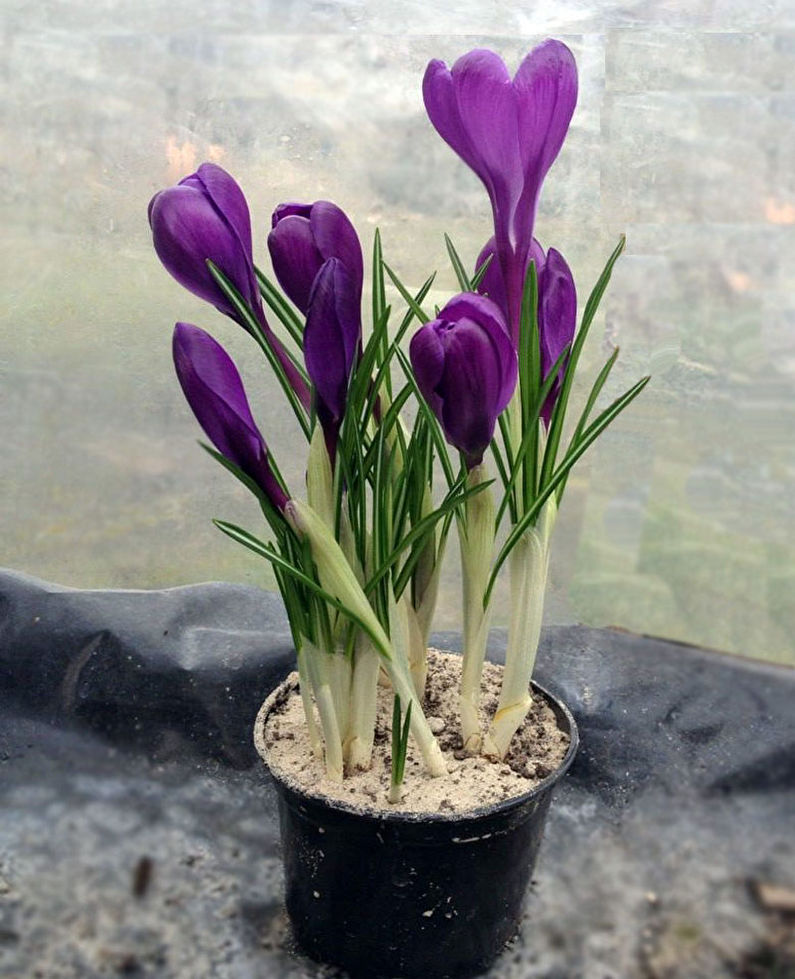
Temperature
The optimal temperature for luxurious flowering is a range from +14 to + 18C. Plants can bloom even at a higher temperature, but they will bloom quite quickly - the buds open early and wither very quickly. In nature, as we said earlier, crocuses bloom in April or September, so there is no need to create special conditions for lawn flowers. With artificial lighting in an apartment, you need to monitor the temperature.
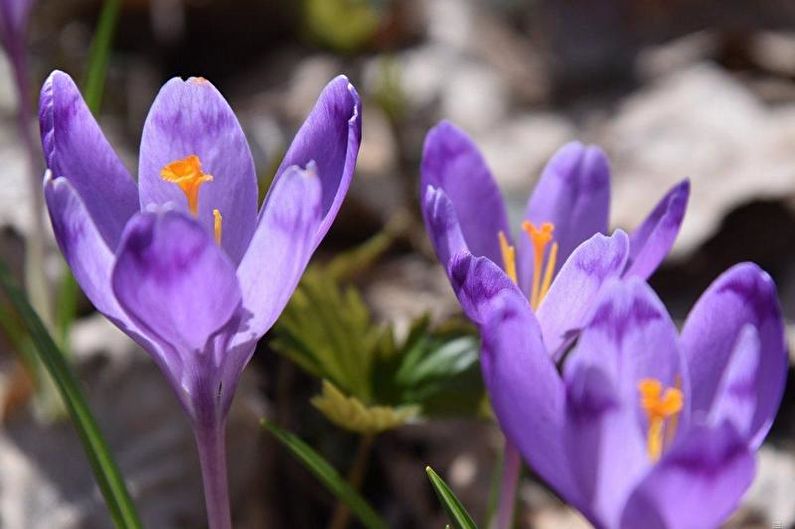
Humidity
Saffron loves moist soil, but at the same time does not tolerate water stagnation, like all bulb plants. It is best to arrange a drainage system in the soil before planting, adding sand and peat.
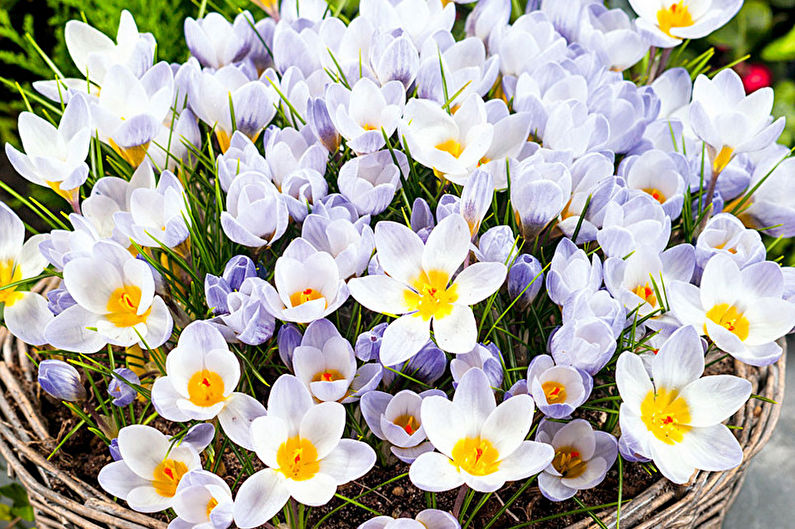
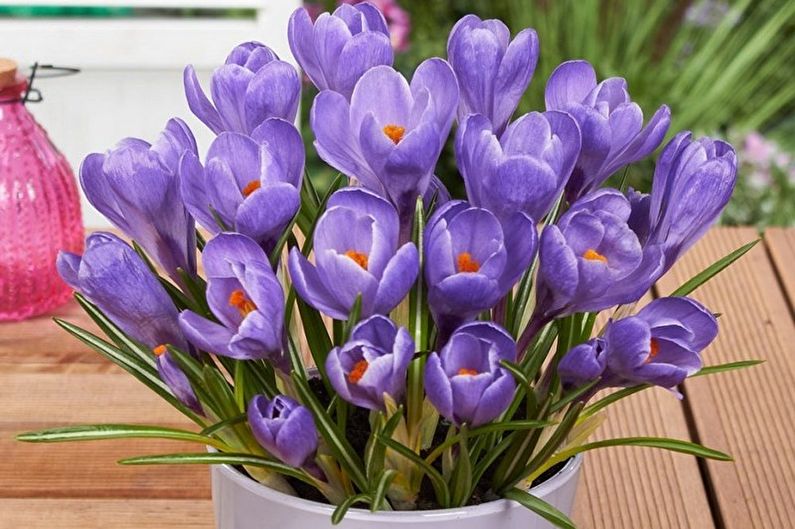
Watering
In open lawns, flowers are watered in a hot season - at high temperatures or when drought is established. It is enough to water once a week, while spending about a bucket of water per 1 sq.m. Watering of saffron ceases when the leaves turn yellow and fall.
At home, water the pot when the top of the soil dries. If in the process of watering part of the glass water in the pan - you need to get rid of it. Watering is recommended at the beginning of the growing season once every two days, after flowering once a week.
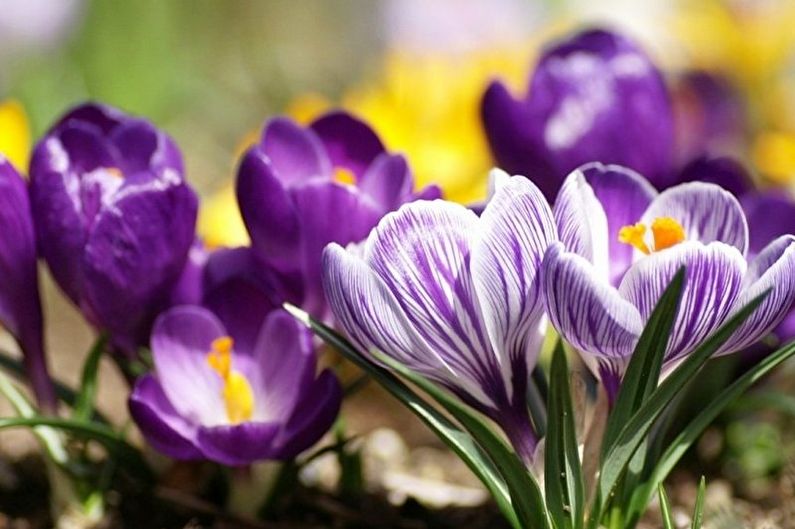
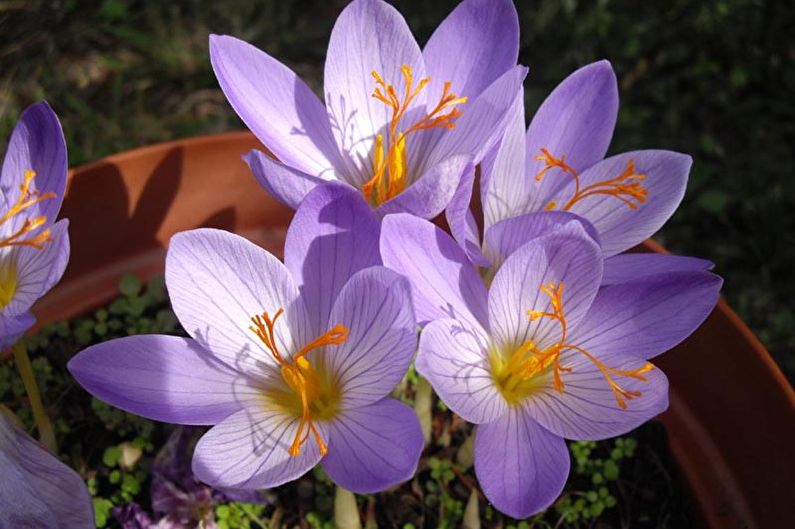
Fertilizers and fertilizing
For crocus, fertile, loose, and fertilized soil is preferred. Before planting, you need to "feed" the soil, adding 1 sq.m. lawn 50 g of fertilizer with trace elements, 20 kg of humus, 80 g of bone meal. It is worth considering that if cultured substrates are used, humus cannot be added, as it will result in a supersaturation of the soil with nitrogen and other elements. In this case, it is better to use a special peat.
The plant can be fed from time to time. The first top dressing takes place a month after planting - add 50 g of calcium nitrate per 1 sq.m to the soil, supply it with potassium nitrate (40 g per 1 sq.m) before flowering, and then - with phosphorus fertilizer in the same proportion.
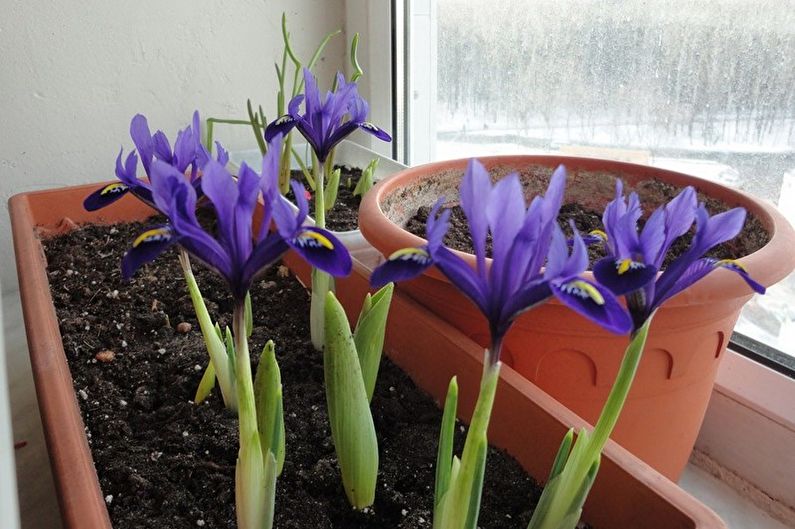

Crocus pests and diseases
In open soils, rodents — field mice — pose a considerable danger to this plant. They not only eat tubers, but also contribute to the spread of various viruses and diseases. Signs of their sabotage can be determined by squeezed buds, gray spots on the petals. Such a flower must be immediately removed from the plantation, since the juice secreted by them falls on neighboring plants and inevitably leads to their death.
Dangerous and fungal diseases that cause rot. If the flowers are planted close to each other, then the root system, which has not had time to grow stronger, will lead to the death of the plant. As a result, the bulb will rot, and nearby crops may suffer. Raw, warm climatic conditions contribute especially to the rotting process. At home, it is not difficult to create the necessary microclimate for plants.
Another problem that gardeners may encounter is the larvae of bugs that have been living for about three years. They literally “drill” the bulbs, causing the plant to die. To get rid of them, you need to lay the tufts of grass in small depressions, moisten and cover with boards. When the bugs move into the new bait, they are burned.
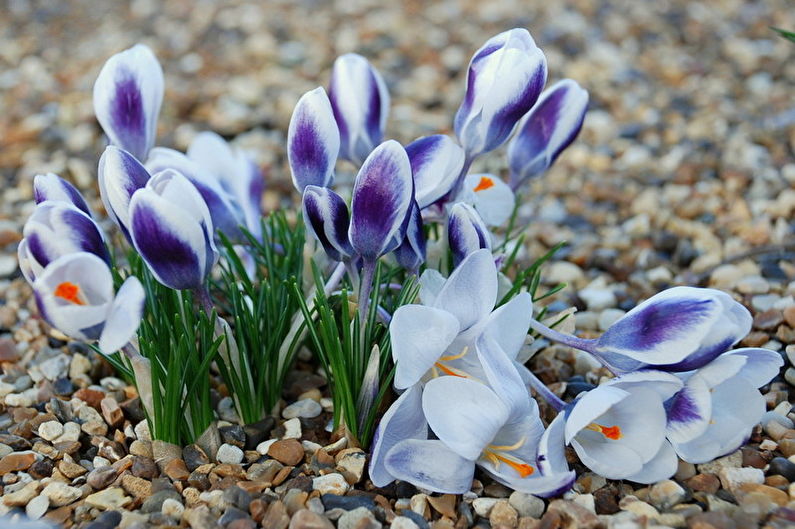
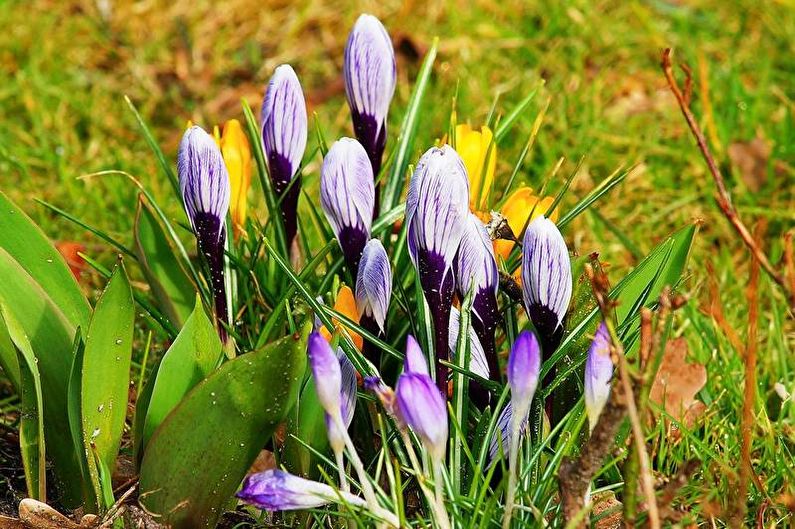
How to transplant crocuses
Flowers can grow in one place for more than 5 years, but it is better to plant them after 3-4 years. When the saffron has faded and the leaves have withered, the corm is removed, dried and stored for storage in a cool place. It is desirable that the temperature was no more than + 10C.
Planting time depends on the variety - if it is spring flowers, then the bulbs are planted in the ground in the fall (September-October), and autumn ones in the second half of the summer.
Indoor plants can be planted at any time, even to coincide with their flowering to the desired date, for this they need to be planted 4 months before the deadline. The tubers are planted in the ground and left in a cool dark place (you can use the cellar). If it is noticed that by 10 weeks sprouts have appeared, the room temperature must be lowered. 15 days before the required flowering date, the flowerpot is brought into the room. The temperature should increase gradually, so initially the flowerpot is left in the corridor, where it is cooler, then it is transferred to the coolest room and, finally, it is installed on the windowsill, closer to the light. Soon, flowers appear.
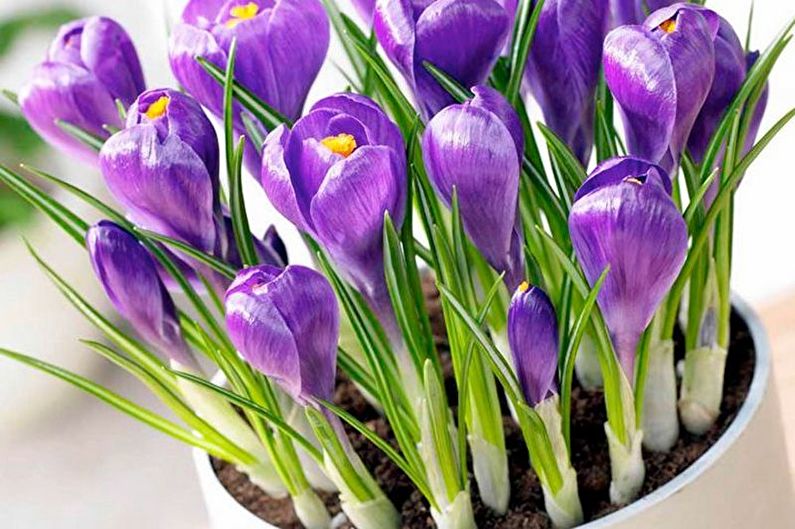
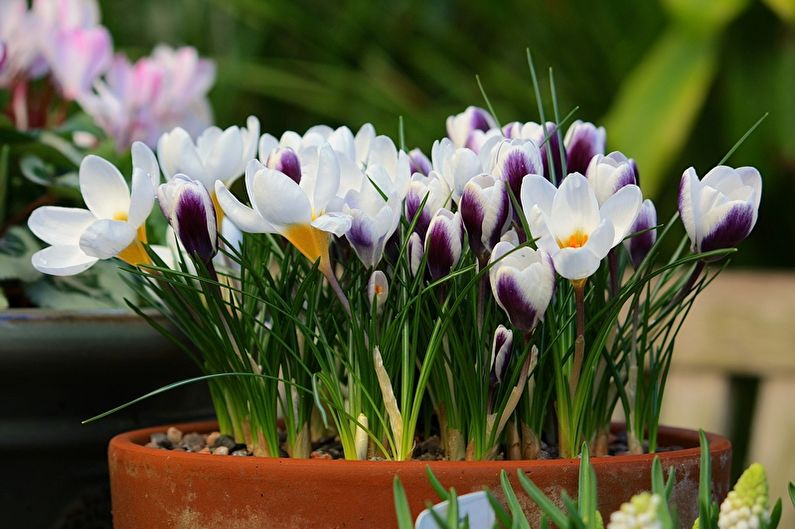
Propagation at home
Propagating crocuses is not difficult. There are two ways here - to use seeds or bulbs. The most commonly used is corms, since the process is much faster.
Crocus seed propagation
When propagated by seeds, they are collected, carefully dried for 7-10 days. Sowing is carried out at a depth not exceeding 1 cm, while observing the distance between the seeds of about 5 cm. Crops will bloom only in the third year, so this method is not very welcomed by flower growers.
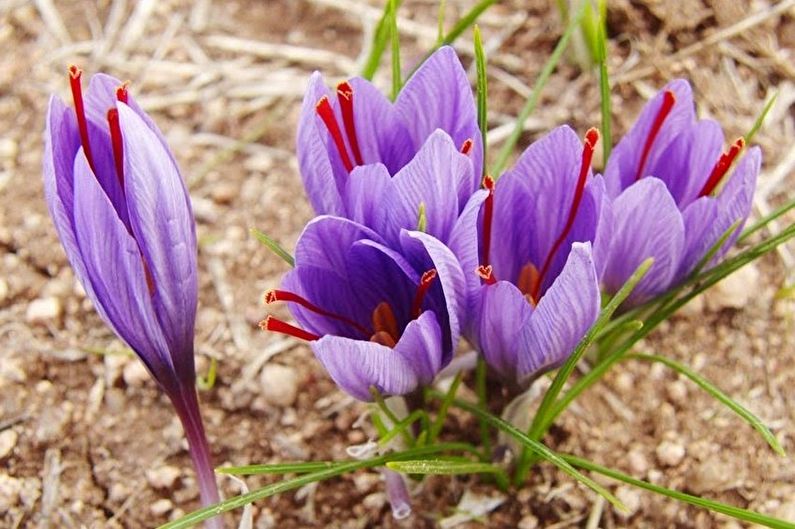
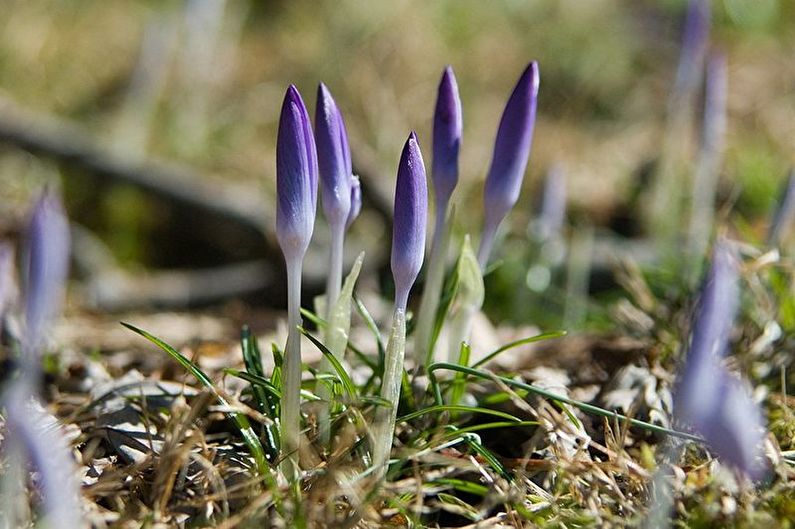
Bulb crocus propagation
The easiest, fastest and most reliable way is bulbs propagation. In the ground, on the scales of the main corm, small onions appear. They form a new colony after the death of the main bulb. To ensure the vital activity of each of them, they need to be seated. After the saffron has flowered, the bulbs are dug up, stored for storage before planting in a cool, ventilated place.
Before planting, it is necessary to carefully inspect the material so that there are no signs of mold and rot. It should be noted that deep planting will slow down vegetative propagation somewhat, but corms will be larger. In the flowerpot, the bulbs can be placed close to each other - then you get a real living bouquet.
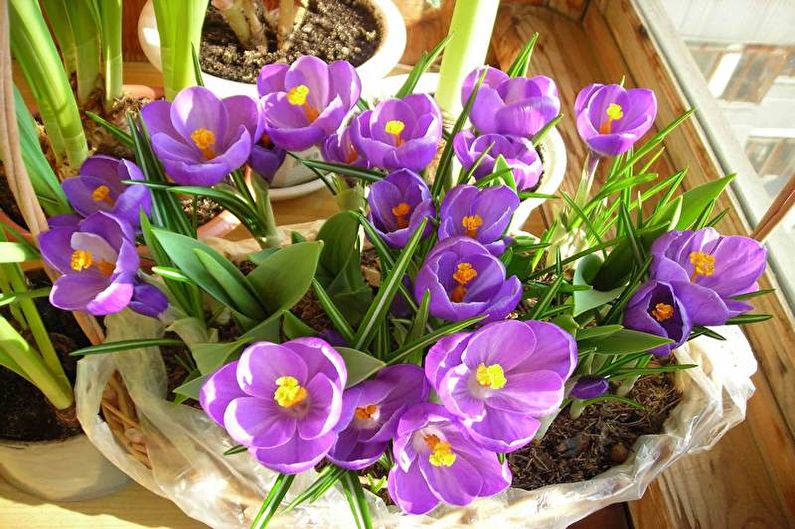
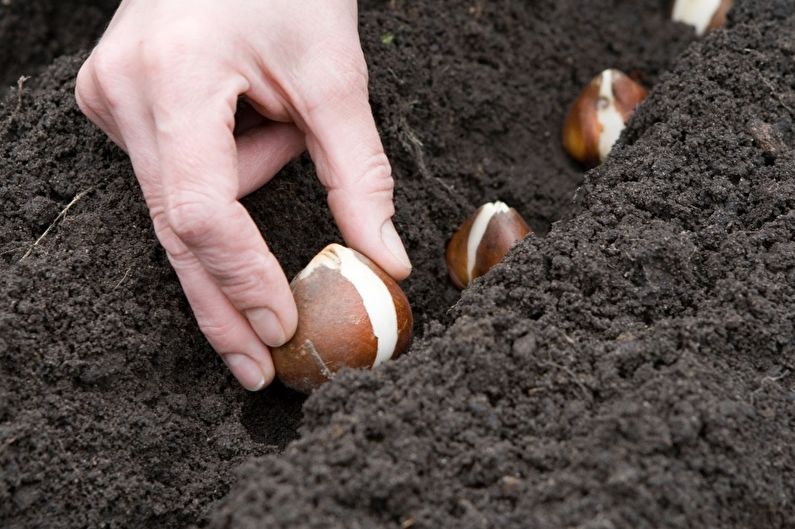

Crocuses - photo
Following simple recommendations, you can get colorful flowerpots and flower beds that will delight your eye. In the meantime, we suggest you enjoy our selection of photos of these amazing plants!
